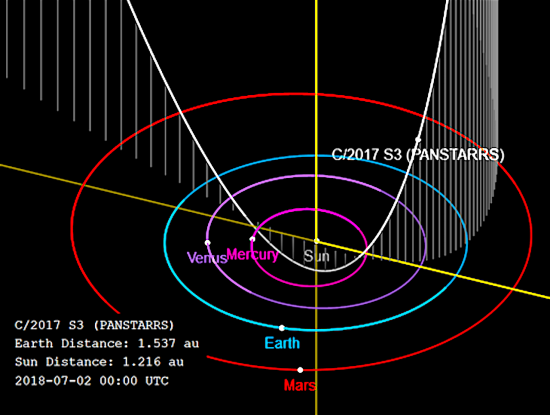
Aug 20, 2019
Another comet exhibits outbursts far from the Sun.
Astronomers recently announced the brightening of a small comet as it passed into the inner Solar System. Called PANNSTARRS (C/2017 S3), the comet began a significant energetic outburst on July 4, 2018 that, according to observers, began “for no apparent reason.” Once it rounds the Sun in August 2018, it is expected to reach a maximum brightness of magnitude 4, barely visible to the naked eye.
The comet joins many others discovered by the PanSTARRS telescope on the summit of the Haleakalā volcano in Maui.
Previous Pictures of the Day note that comets tend to split, or to undergo anomalous displays when they near their farthest distances from the Sun. Because conventional theories based exclusively on gravity expect disruptions only at close approaches, that sort of activity is surprising.
When Comet Linear blew apart in July of 2000, the strangest thing about its fragmentation was that it occurred at a distance of over 100 million kilometers from the Sun and not when it passed by during perihelion. Another counter-intuitive observation is that “Sun-grazer” comets do not break apart even when they reached as close as 50,000 kilometers to the Sun’s photosphere. The “dirty snowball” theory cannot account for such activity at distances where solar energy emissions are so weak that ice will not melt.
If solar heating were responsible for cometary discharges at such distances, then all the frozen moons of Jupiter would be as dry as deserts and would look more like our own Moon than the icy bodies that they are. If the Sun is not the impetus those displays, then what provides the energy for supersonic blasts of dust and ice when comets are so far away?
In an Electric Universe, comets and their electric charges develop during the time when they are far from the Sun where charge density is low. Since they move slowly, their electric potential attempts to reach equilibrium with the weak, radial solar field. Comets experience a steadily increasing voltage and current density as they accelerate toward the Sun, forming plasma sheaths, or comas, as they travel. PANNSTARRS (C/2017 S3) possesses a coma larger than the planet Jupiter.
Eventually, a cometary coma switches to an arc mode discharge state, forming cathode jets and dusty ion tails. Bright spots on black nuclei indicate locations where electric arcs touch down. Unexpected X-rays have been detected coming from the comet’s plasma sheath. The energy required to generate X-rays is supplied by the comet’s electrical discharge. Comet Hyakutake was a good example. If the charge imbalance becomes too great, the nucleus may explode like an over-charged capacitor, breaking into fragments or vanishing forever.
Most comets have a nucleus no more than 16 kilometers in diameter. They carry a negative charge with respect to the Sun, so they begin to discharge violently when they approach the inner Solar System. However, their mass is low and their electric fields are correspondingly weak. When Deep Space 1, the first spacecraft with an ion propulsion drive, flew past comet Borrelly, it appeared more like an asteroid, possessing a dry, hard surface: no traces of ice or snowy fields.
Comets adjust to changing plasma potentials as they move toward or away from the Sun. That adjustment is not a problem on the slow journey through the outer reaches of the Solar System. However, as mentioned, visible electric discharges occur as the comet speeds through the inner Solar System.
Since a comet nucleus behaves like a capacitor, if a discharge occurs inside its body, it will explode violently. That is what causes comet nuclei to fragment, and it is why the event is commonly preceded by energetic outbursts. The energy is provided by the stored electric potential within the nucleus.
Stephen Smith
The Thunderbolts Picture of the Day is generously supported by the Mainwaring Archive Foundation.












